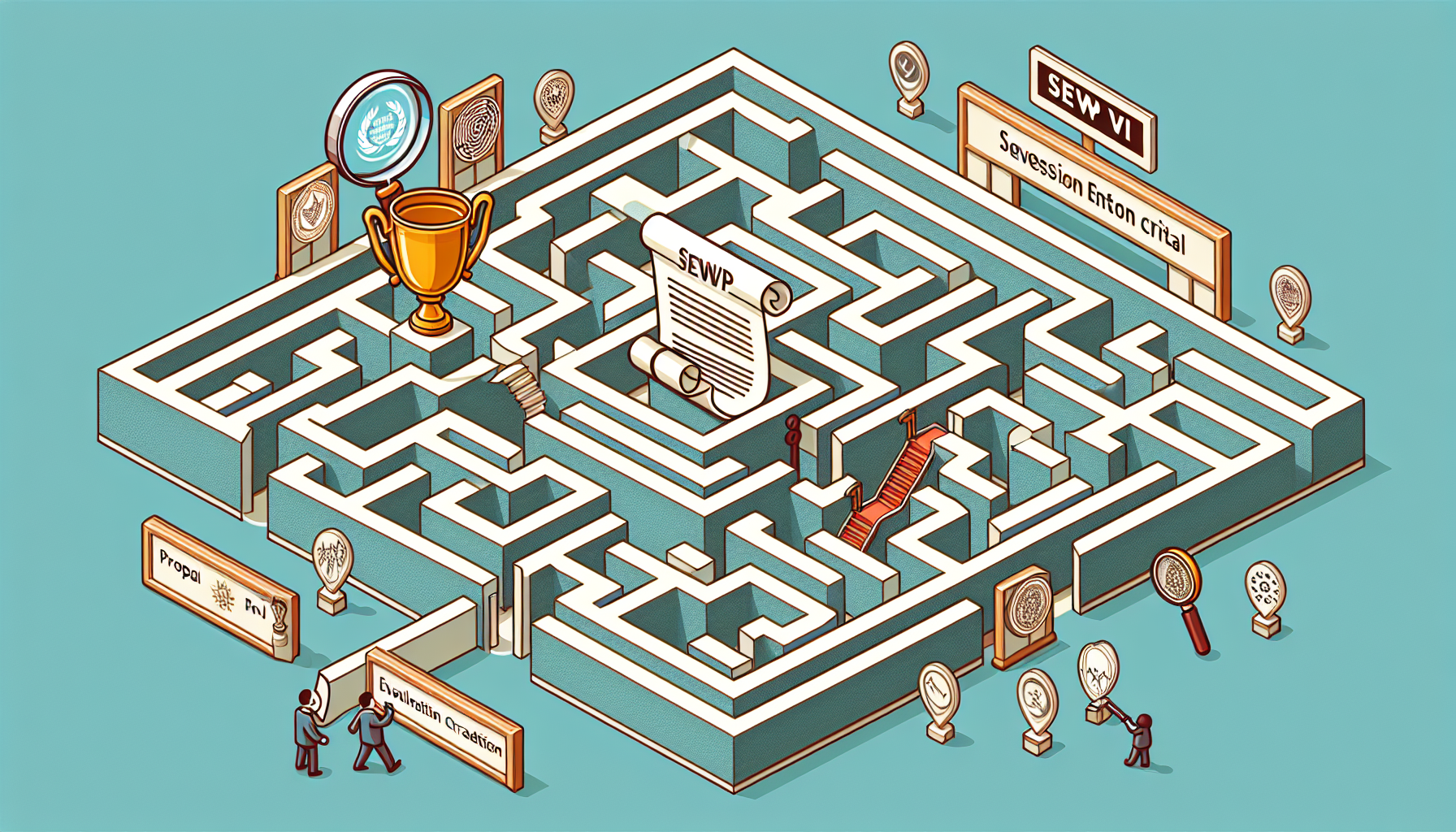SEWP VI
In the landscape of government IT procurement, stands a towering beacon of innovation and efficiency - NASA’s Solutions for Enterprise-Wide Procurement (SEWP) VI. This next iteration of the SEWP program promises to redefine the approach to IT procurement, fostering collaboration, innovation, and small business empowerment.
Key Takeaways
- SEWP VI introduces significant changes in federal IT procurement, emphasizing emerging technologies, integrating services at the Master Contract level, and broadening procurement scope with various contract types.
- The program stresses the importance of cloud solutions and data analytics, which provide federal agencies with innovative tools for efficiency, while AI enhances decision-making processes in government procurement.
- SEWP VI offers substantial opportunities and guidance for small businesses, including set-asides and strategic partnerships, while also presenting challenges such as competitive bidding and navigating program complexities.
Demystifying SEWP VI: Key Aspects and Changes

SEWP VI, the sixth iteration of NASA’s highly successful Solutions for Enterprise-Wide Procurement program, is a government-wide acquisition contract (GWAC) set to revolutionize federal IT procurement. Managed by the SEWP Program Office, this new contract vehicle, known as NASA SEWP VI, introduces a realm of transformative changes, aligning with emerging technological advancements and evolving government requirements.
The draft Request for Proposal (RFP), a crucial part of the procurement process, provides an early look at the key aspects and changes of the SEWP VI contract. With the release of the sewp vi draft rfp, potential bidders can better prepare for the final solicitation, anticipated to be released in February, underscoring the commitment to transparency and stakeholder engagement.
Growth in IT Procurement
The growth in IT procurement is buoyed by:
- Increasing demand for technology solutions
- Necessity to modernize IT infrastructure
- Transition towards digital transformation
- Emergence of e-commerce
- Significance of data security
- Pursuit of cost savings and operational efficiency through federal government’s vehicle
These factors contribute to the growth of IT procurement.
Emerging technologies such as AI, blockchain, and RPA are reshaping IT procurement by making processes more efficient, enhancing decision-making, and boosting productivity. Federal regulations encompassing minimal criteria for cybersecurity contracts, regulations for threat hunting and secure software development, and recommendations for artificial intelligence technologies are redefining IT procurement.
Expanding Scope and Services
SEWP VI breaks new ground by integrating services at the Master Contract level, facilitating the acquisition of a comprehensive solution for government agencies’ IT needs. The integration of services at this level simplifies the process, enabling a diverse array of professional services to be encompassed within a single contract, thus streamlining procurement processes. This broadens the scope and spending capability through the contract vehicle, allowing for the incorporation of various contract types at the order level to meet the diverse requirements of federal agencies.
Contract categories at the order level include Labor Hour, Time and Material, Fixed Price Award Fee, Fixed Price Incentive Fee, and Firm Fixed Price.
Embracing Innovation: New Technologies and Solutions

SEWP VI strongly emphasizes emerging technologies, especially in the realm of cloud solutions. These technologies encompass:
- Cloud services architecture
- Design
- Implementation
- Enterprise migration to cloud environments
These provide robust and innovative options for federal agencies, including innovation services and the federal government’s vehicle choices.
Data analytics is another tool leveraged in SEWP VI to:
- Gain valuable insights
- Make informed decisions
- Enable the analysis of trends
- Monitor performance metrics
- Fine-tune processes for greater effectiveness in government procurement.
Artificial intelligence, including machine learning, contributes to the enhancement of SEWP VI’s capabilities through the automation of tasks, improved data analysis, and more efficient decision-making.
Cloud Solutions
Cloud solutions provide flexibility and scalability for federal IT infrastructure by granting on-demand access to computing resources, enabling federal agencies to:
- Modify their infrastructure according to evolving demands
- Benefit from services such as cloud services architecture, design, implementation, and enterprise migration to the cloud, including managed services
- Access competitive pricing and value for federal IT procurement.
Advantages of cloud solutions in federal IT infrastructure include:
- Continuous improvement
- Business continuity
- Disaster recovery
- Operational efficiency
- Cost-effectiveness
- IT systems modernization
These advantages make cloud solutions and network services an indispensable part of federal IT infrastructure.
Data Analytics and AI
Data analytics performs a host of specific functions in SEWP VI, including:
- Delivering insights
- Pinpointing trends and patterns
- Improving forecasting
- Enhancing supplier performance evaluation
- Bolstering compliance and risk management
AI enhances efficiency and revolutionizes procurement processes by analyzing large amounts of data to identify trends and patterns, helping government agencies make informed decisions.
Instances of data analytics and AI applications in government IT procurement encompass predictive analytics, data analysis, forecasting procurement needs, utilization of generative AI, and fostering an ‘AI-ready’ culture. Data analytics has enhanced decision-making in SEWP VI by offering government agencies streamlined procurement, competitive pricing, access to cutting-edge technologies, and a wide range of IT services.
Small Business Empowerment: Opportunities and Challenges

SEWP V has paved the way for its successor, sewp v, which represents a promising opportunity for small businesses, offering them a chance to participate in the sphere of government procurement. It fosters their growth and enables them to compete for contracts on par with larger companies, thereby encouraging diversity and competition. However, the path isn’t always smooth. Small businesses encounter numerous obstacles within sewp v, including:
- The fiercely competitive bidding process
- Barriers to entry resulting from regulations and business practices
- Adherence to set-aside requirements
- Fulfillment of performance criteria
- Navigating the complexities of the program
Small Business Set-Asides
Small business set-asides in the context of government contracts refer to contracts that are reserved by the federal government specifically for qualifying small businesses. These set-asides limit competition to small businesses and provide them with opportunities to secure government contracts. The set-aside process fosters diversity and competition in the IT industry by providing opportunities for small businesses, including those owned by minorities, women, and veterans, to participate in government contract competitions.
In order to qualify for a set-aside under the SEWP program, small businesses must adhere to the eligibility criteria established by the Small Business Administration (SBA). Approximately 48% of SEWP IV spending is channeled through small businesses, demonstrating the program’s dedication to fostering small business participation.
Partnering Guidance
Small businesses can establish strategic alliances within SEWP VI by cultivating relationships with government agencies, engaging in mentor-protege programs, and partnering with other small businesses in the same industry. These partnerships must adhere to the scope category requirements of the solicitation and validate the relationship with an OEM/Provider by providing a point of contact.
These partnerships provide various advantages for small businesses, such as:
- Access to a wider range of assets and knowledge through alliances and associations
- A more efficient procurement process
- Competitive pricing
- Access to the latest IT technologies
- Opportunities for enterprise-level IT services
Preparing for SEWP VI Industry Day

Scheduled for October 18th, the SEWP VI Industry Day serves as an invaluable platform for:
- Fostering mutually beneficial relationships
- Enhancing industry engagement
- Leading to more streamlined and cost-effective procurement practices for the government
The event serves to facilitate dialogue and provide clarity.
It benefits companies by providing them with:
- Access to insights and information on the SEWP contracts
- Enabling them to stay informed
- Gain a better understanding of the procurement process
- Enhance their prospects of securing contracts.
Event Agenda
The agenda for the SEWP VI Industry Day includes:
- Planned follow-up to the current SEWP contracts
- Information on the upcoming SEWP VI RFP
- Perspectives from industry representatives
- Discussions on ideas, concerns, and solutions related to SEWP VI.
The main updates to be addressed at the SEWP VI Industry Day include significant changes announced by NASA to its SEWP VI Government-wide IT products and services contracts.
The steps involved in the proposal submission process for the SEWP VI Industry Day include:
- Evaluating if your company can meet the requirements
- Obtaining necessary certifications within 12 months of contract award
- Submitting the proposal based on the formal document outlining the requirements and guidelines provided by NASA.
Networking Opportunities
To make the most of networking opportunities at SEWP VI Industry Day, it’s recommended to research the companies and organizations that will be attending and prepare an effective elevator pitch. Professionals from both the government and industry sectors typically participate in the SEWP VI Industry Day, creating a diverse environment for networking.
Previous participants have utilized networking opportunities at SEWP VI Industry Day by:
- Engaging with government representatives and industry professionals
- Utilizing the event as a platform to cultivate connections
- Sharing ideas
- Investigating potential partnerships.
Navigating the SEWP VI Proposal Process

A significant aspect of the SEWP VI journey involves understanding and successfully navigating the proposal process. The obligatory requirements under SEWP VI consist of obtaining ISO 9001:2015 certification for Category A and CMMI Certification for Categories B and C. For categories B and C, it is also required for contractors to comply with minimums for Relevant Experience Projects (REP). This ensures that contractors have the suitable experience for the specific projects..
The three phases of the SEWP VI competition encompass pass/fail certification and mandatory experience, the submissions of the Offer volume, as well as Past Performance and Mission Suitability volumes.
Mandatory Requirements
The requirement for both ISO 9001:2015 certification and REP minimums for SEWP VI proposal submissions is in place to verify that vendors have exhibited compliance with quality management standards (ISO 9001:2015) and possess pertinent expertise in the specified areas (REP minimums). All offerors must furnish third-party validation of a current ISO 9001:2008 or 9001:2015 Certification.
In order to fulfill the REP minimum requirement for SEWP VI, a company must possess:
- A minimum of three Representative Experience Projects (REPs) in the mandatory areas
- A minimum value of $2 million for Small Businesses
- Specific requirements for HUBZone, SDVOSB, and EDWOSB small businesses
These standards are essential for a proposal to be deemed compliant and receive a high score, and are a prerequisite for advancing in the evaluation process.
Evaluation Criteria
Past performance holds significant importance in the evaluation process for SEWP VI, where the contractor’s capacity to meet requirements is thoroughly analyzed. Confidence levels, ranging from neutral to very high, are determined based on past performance assessments.
Mission suitability volumes are determined in the third phase of evaluation, and the criteria vary based on the size of the business. The imposition of a 30-page limit in the SEWP VI evaluation criteria is intended to encourage proposers to create succinct, well-organized proposals that showcase their expertise.
Lessons from Reverse Industry Day
Collaboration and feedback are key to enhancing the SEWP VI framework, ensuring it aptly caters to the needs of both the government and industry. The primary recurring themes that were examined during Reverse Industry Day included:
- Certification
- Requirement
- Terms
- Deliverables
- Goals
Reverse Industry Day (RID) events are forums where industry experts play a central role in sharing their insights, challenges, and expertise with government officials. RID serves as a dynamic brainstorming session, enabling industry leaders to directly engage with NASA representatives in order to enhance and refine the SEWP framework.
Collaboration and Feedback
In order to improve collaboration and feedback within the SEWP VI framework, it is crucial to conduct Proposal Readiness Reviews (PRRs) to ensure compliance with RFP specifications, certifications, and past performance requirements. Additionally, actively seeking feedback on performance and making necessary adjustments is vital for enhancing collaboration and the effectiveness of the framework.
The SEWP VI framework provides benefits to both the government and industry through the utilization of collaboration and feedback to effectively address their collective needs. It achieves this by:
- Facilitating open communication and active engagement between stakeholders
- Initiating initiatives such as Reverse Industry Days
- Providing platforms for submitting comments and questions
Key Takeaways
Several of the significant secondary topics and unresolved inquiries include:
- The necessity for an on-ramp and off-ramp for industry participants
- The significance of government evaluation of industry questions and comments
- The intention to publish a summary of those industry questions and government responses on the SEWP VI website.
Tactics such as industry deep dives, strategic discussions, and feedback sessions, which were utilized in previous SEWP frameworks, have influenced the development of SEWP VI. These practices, along with insights from reverse industry days, have been honed and incorporated to establish effective collaboration and feedback mechanisms.
Summary
In conclusion, SEWP VI is poised to redefine government IT procurement by embracing innovation, expanding scope and services, and empowering small businesses. With its emphasis on collaboration and feedback, and a commitment to efficient and effective procurement practices, SEWP VI is set to be a transformative force in the federal IT procurement landscape.
Frequently Asked Questions
What is a SEWP contract?
A SEWP contract, or Solutions for Enterprise-Wide Procurement, is a multi-award Government-Wide Acquisition Contract (GWAC) focused on IT products and product-based services. It is available for use by all Federal Government agencies and their authorized subcontractors.
What is the difference between NASA SEWP and GSA?
The main difference between NASA SEWP and GSA is that SEWP allows agencies to purchase complex IT solutions in a single order, while GSA contracts would require separate orders. Both are indefinite delivery/indefinite quantity contracts.
What is the NASA SEWP fee?
The NASA SEWP fee, as of October 1, 2020, is a 0.34% surcharge that must be included in the price of the products and cannot be shown as a separate line on the quote.
Who is the leader of NASA SEWP?
The leader of NASA SEWP is Joanne Woytek, who serves as the Program Director for the NASA SEWP Program.
What does NASA SEWP V stand for?
NASA SEWP V stands for "Solutions for Enterprise-Wide Procurement" and is a United States Government-Wide Acquisition Contract managed by NASA that provides IT products and services for federal agencies and their approved contractors.